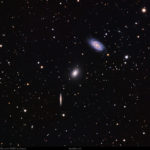M101 – The Pinwheel Galaxy – is a spectacular, face-on “Grand Design” spiral galaxy located about 20 million light years away. It is quite a hard object to observe visually unless your skies are dark due to the galaxy’s very low surface brightness. In the image below you can see the many red HII (pronounced “H-two”) star forming regions. The galaxy is not a part of the local group of galaxies and is receding away from us with the expansion of the universe.
The image was acquired in my back yard observatory in Nottingham, UK with my TEC140 refractor and Atik 460 CCD camera with LRGBHa Astrodon Filters between 2018 and 2020. I used off-axis guiding to keep the telescope precisely aligned and the whole imaging ensemble was atop my MESU200 mount. M101 is not easily captured from my observatory since it is sandwiched between the neighbour’s house and my house meaning that I can only grab it when it is almost at the zenith, which is where I captured these images in the early springtimes. Consequently, it took several years to acquire the data needed to build the image.
The imaging data set is as follows:
Luminance > 20 x 900s binned 1×1 ; Red > 18 x 300s 2×2 ; Green > 18 x 300s 2×2 ; Blue > 18 x 300s 2×2 ; Ha > 24 x 300s 1×1
This gives a total integration time of about 11.5 hours. This is a large investment of time on a single object in the UK skies, where clear nights are a great rarity.
I used Sequence Generator Pro for image capture. I then used PixInsight for pre processing to get to the five LRGBHa master files. I then used PixInsight to create the HaRGB and Luminance master TIFF files. I then switched to Photoshop to do the blending of these two L and HaRGB with multiple layers of blending saturation and tweaking. As I have mentioned elsewhere, I find it easier and more intuitive to do this in Photoshop as opposed to LRGB combination tool and/or PixelMath in PixInsight since blending inside Photoshop gives immediate feedback off the effect when the sliders are tweaked. A personal preference and I am sure many folks are completely happy doing this task purely inside PixInsight.
Above is five hours of luminance only. It reveals much of the fine structure inside the galaxy’s core and spiral arms. This data was then blended into the RGBHa composite.







Comments are closed.